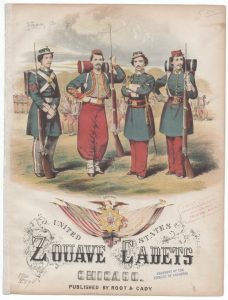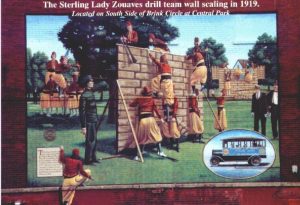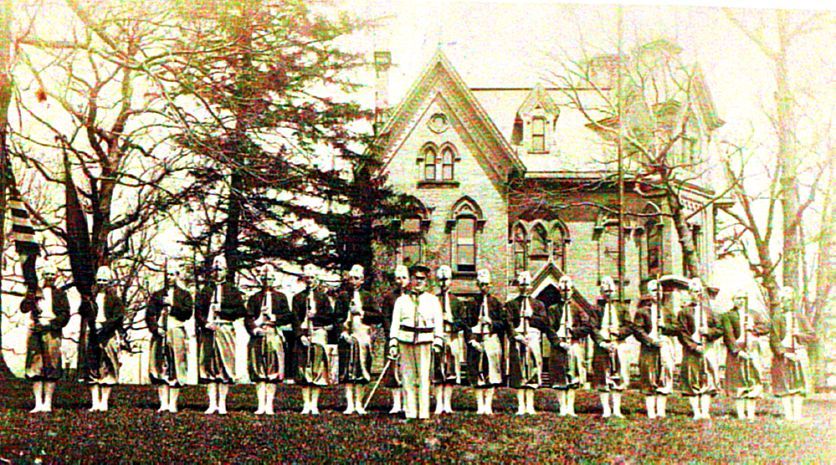On The March in Quick-Time: A Zouave Demonstration

 With the Virtual World Tour for First Fallen: The Life of Colonel Elmer Ellsworth, the North’s First Civil War Hero underway, I have been collecting frequently asked questions. The most popular queries by far concern Ellsworth’s actual Zouave drill. What did it look like? Why was it entertaining? How does it relate to the military drill of today? One gentleman last week was discussing his son’s appointment as a major in the current Old Guard Brigade–1st Battalion, 3d U.S. The Old Guard is the oldest Infantry unit in the Army, dating back to June of 1784. It was given the name “The Old Guard of the Army” by General Winfield Scott after a bayonet charge on the Mexican citadel Chapultepec in 1847. These guys march a lot!
With the Virtual World Tour for First Fallen: The Life of Colonel Elmer Ellsworth, the North’s First Civil War Hero underway, I have been collecting frequently asked questions. The most popular queries by far concern Ellsworth’s actual Zouave drill. What did it look like? Why was it entertaining? How does it relate to the military drill of today? One gentleman last week was discussing his son’s appointment as a major in the current Old Guard Brigade–1st Battalion, 3d U.S. The Old Guard is the oldest Infantry unit in the Army, dating back to June of 1784. It was given the name “The Old Guard of the Army” by General Winfield Scott after a bayonet charge on the Mexican citadel Chapultepec in 1847. These guys march a lot!
I have looked at hours of YouTube drill videos, from one or two reenactors demonstrating a bayonet charge to an entire regiment at Arlington. When I am asked to describe the Zouave Infantry drill, I do my best. I know a lot of terms, and I use them properly, but there is nothing like a moving image to make the Algerian Zouave drill of yesterday really come to life. When the gentleman from the Inland Empire Civil War Round Table brought up the Old Guard I thought, “Meg, you can do better.”
Here is better: American Legion Zoauves
And: Devlin’s Zouaves from Buffalo Bill’s Wild West

Have fun!

Tradition and heritage are big things in the military services — especially in the Army, the oldest of the military services … so, perhaps the proud old gent with the grandson in the Old Guard is referring to U.S. Army Drill Team, the 4th Battalion, 3rd U.S. Infantry Regiment … it’s not a stretch to believe the Old Guard”s team, and others in each of military services, are inheritors of the precision drill of Colonel Ellsworth’s Zouvaes.
Here’s six minutes of awesome from the Old Guard:
https://www.youtube.com/watch?v=ev_W4AGh0co&t=137s
The Marine Corps Silent Drill Platoon is equally fabulous … and if you live in the DC area, both these units of great Americans perform for the public throughout the summer.
Thanks for this great post … that was some excellent detective work finding that clip from 1953.
Just great drill. Ellsworth used the silent drill in his performances as well as the “tap” drill where the series of maneuvers was done to drumtaps. At the end of your clip the soldiers toss their weapons backward. Ellsworth used this maneuver when his men were “firing.” Three or four zouaves were a team–the best shot was prone and facing the enemy. They had single-shot rifles, so after the sharpshooter fired, he threw the musket back without looking. Then he reached for a freshly-loaded gun while the just-fired gun was cleaned and reloaded. It was as close to automatic fire as it was possible to get in the 1860s. After all, a Gatling gun couldn’t be aimed like an individual rifle. (Can you tell I love this stuff? LOL!)
thanks Meg … i think you struck gold with this post … after 38 years in the military, i always wondered where the silent drill and rifle flinging came from … now i know!!! Many thanks to you.
Whoa. That is way too much marching and drilling for this veteran. Its nice to watch, but count me out!
Tom
Aw come on! No double time for you?
I love the Devlin’s Zouaves’ maneuvers! Thank you for this post!
The wall-climbing is still used by the Rangers, Seals, etc. Gives me thrills, even with the jerky film.
Here’s a Zouave drill team on the Ed Sullivan Show January 18, 1953
https://www.youtube.com/watch?v=EcZeGu1ynbc&t=10s
and a vaudeville comedy Zouave drill in the Buster Keaton short The Playhouse (Zouaves are
about 15 minutes in)
But wait! There’s more! https://www.facebook.com/shaun.grenan/videos/10217272622540590